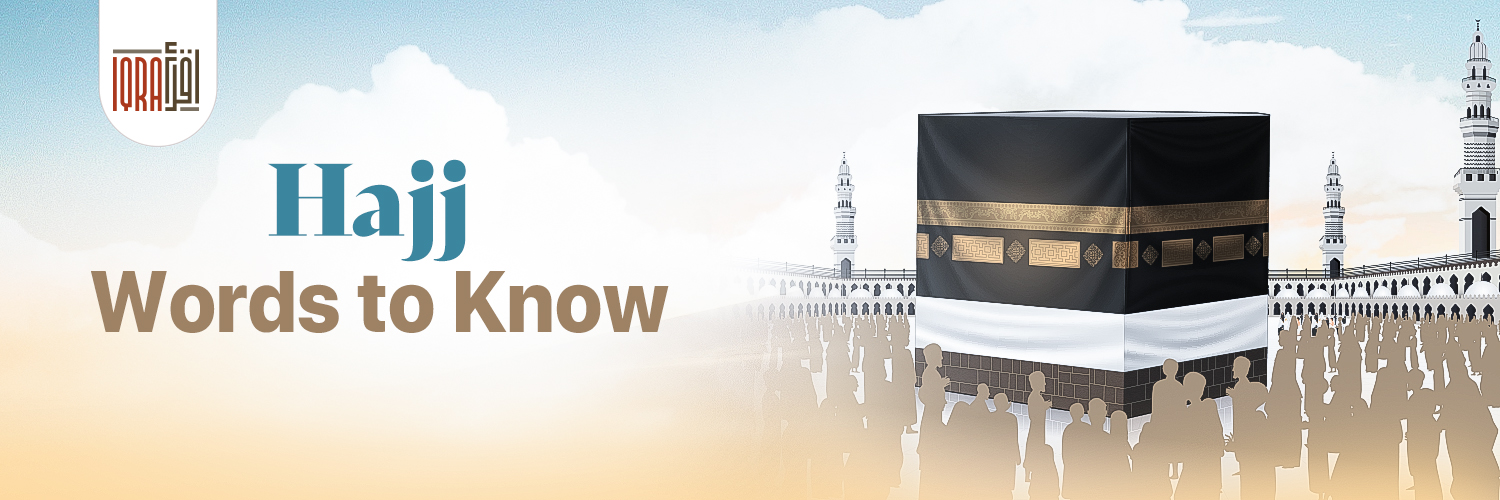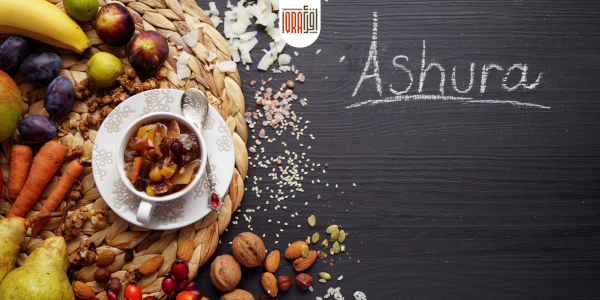An Easy-to-Understand Breakdown of Hajj Terms
Are you feeling overwhelmed by the thought of performing Hajj? Have you read some online resources or books and found it difficult to understand?
We can relate! There are many resources online to help a person learn the ins and outs of Hajj. But weaved within these resources are many Arabic terms, and having Hajj explained is a challenging thing to go through. So, we’ve compiled a glossary of the most common words when looking into Hajj. Below you’ll find not just the meaning of the word but also the context.
A Glossary of Hajj Explained
What is Niyyah?
Niyyah means to intend to do an action. It is an act of the heart and said within. But to fortify your intention, one can verbally say it.
The niyyah (intention) for Hajj is:
للَّهُمَّ حَجًّا لَبَّيْكَ
Labbayk Allahumma Hajj
O Allah, here I am to perform Hajj
اللَّهُمَّ إِنِّيْ أُرِيْدُ الْحَجَّ
Allahumma Innee Ureedul Hajj
O Allah, I intend to perform Hajj
اللَّهُمَّ إِنِّيْ أُرِيْدُ الْحَجَّ فَيَسِّرْهُ لِيْ وَتَقَبَّلْهُ مِنِّيْ
Allahumma Innee Ureedul Hajja fa Yassir-hu lee wa Taqabbal-hu Minnee
O Allah, I intend to perform Hajj, so make it easy for me and accept it from me
The niyyah (intention) for Umrah (for Hajj Tammatu, performed before one makes Hajj) is:
للَّهُمَّ حَجًّا لَبَّيْكَ
Labbayk Allahumma Umrah.
O Allah, here I am to perform Umrah
اللَّهُمَّ إِنِّيْ أُرِيْدُ الْعُمْرَةَ
Allahumma Innee Ureedul Umrah.
O Allah, I intend to perform Umrah
اللَّهُمَّ إِنِّيْ أُرِيْدُ الْعُمْرَةَ فَيَسِّرْهَا لِيْ وَتَقَبَّلْهَا مِنِّيْ
Allahumma Innee Ureedul Umrata fa-Yassirhaa lee wa Taqabbal-haa Minnee
O Allah, I intend to perform Umrah, so accept it from me and make it easy for me.
What is Hajj Tamattu’?
Tamattu means “enjoyment.” This is the most common type of Hajj. It is for pilgrims who arrive earlier in Makkah. They can perform Umrah but only have to be in Ihram once Hajj begins. They make Tawaf, do Sa’ee, and trim their hair just as they would for Umrah. However, when they finish, they can remove their Ihram (thus, conditions of the Ihram are removed). When Hajj begins on the 8th of Dhul Hijjah, they again put on (go into the state of) their Ihram to perform Hajj.
What is Mutamatti?
The pilgrim performing Hajj Tamattu is called a Mutamatti.
What is Hajj Ifrad?
Hajj Ifrad is when the pilgrims wear Ihram only for Hajj. When they reach Makkah, they perform Tawaf and Sa’ee but do not remove or cut their hair as in Umrah. They remain in Ihram; thus, they must fulfill all the conditions of the Ihram until Hajj begins.
What is Hajj Qarin?
Hajj Qiran is also known as “accompanied Hajj.” The pilgrim wears their Ihram with the intention of both Umrah and Hajj. The person performing this Hajj can only remove their Ihram after completing it. Part of the requirement is to sacrifice an animal.
What Is Mufrid?
This Hajj is also known as “isolated Hajj.” The pilgrim wears Ihram only for Hajj. When they reach Makkah, they perform Tawaf and Sa’ee but do not remove or cut their hair. They remain in Ihram; thus, the conditions of the Ihram remain until Hajj ends. This option suits people that arrive right before Hajj begins.
What is Ghusl?
Ghusl is a ritual purification that requires one to clean their entire body (unlike wudu).
What is Wudu?
Wudu is a ritual purification that requires one to clean certain body parts. Four parts are mandatory: washing the face, arms, the head, and the feet.
What is Hayd?
Hayd is menstruation. Women cannot perform Tawaf and Sa’e while on their period; they can complete all the other Hajj rites (going to Mina, Arafat, Muzdalifah, and pelting the Jamarat).
What is Ihram?
Ihram is a physical and spiritual state one must go into. From a material perspective, Ihram, for men, is wearing two pieces of clean, unstitched cloth (typically white). For women, Ihram means clean clothes that fully cover. A person cleans themselves (trimming hair, bathing, doing ghusl/wudhu) before wearing Ihram. When they are in Ihram, conditions are put on them; thus, they are in the state of Ihram.
Being in the state of Ihram means a person must abstain from some of the following:
– using anything with a scent
– cutting their nails or hair
– killing anything unless one fears harm from it (including hunting)
– any obscenity in behavior and speech (violent speech)
– sexual intercourse
What is Rida’?
The upper cloth of the Ihram (for men) is called rida.
What is Idhteba’ or Idhtibaa?
Idhteba’ applies to men in Ihram. When they perform Tawaf, they must perform “Idhteba.” They should uncover their right shoulder by removing the upper cloth of their Ihram (rida) and tucking it under their right arm, with the ends of it over the left shoulder.
What is Talbiyah?
The Talbiyah is the pilgrim proclaiming their response to Allah, inviting them for Umrah or Hajj. It starts by saying “Labbayk,” meaning “I am present.”
Men recite this loudly, while women recite it quietly. The recitation should continue as pilgrims embark on their journey to perform Umrah or Hajj.
– لَبَّيْكَ اللهُمَّ لَبَّيْكَ – لَبَّيْكَ لَا شَرِيْكَ لَكَ لَبَّيْكَ – إِنَّ الْحَمْدَ وَالنِّعْمَةَ لَكَ وَالْمُلْكَ – لَا شَرِيْكَ لَكَ
Labbayka llāhumma labbayk(a), labbayka lā sharīka laka labbayk(a), inna l-ḥamda wa n-ni’mata, laka wa l-mulk(a), lā sharīka lak.
What is Takbeer al Tashreeq?
From Fajr salat on the 9th of Dhul Hijjah up to (and including) after Asr salat on the 13th of Dhull Hijjah, pilgrims must recite the Tabkeer al Tashreeq.
اللَّهُ أَكْبَرُ اللَّهُ أَكْبَرُ لَا إلَهَ إلَّا اللَّهُ وَاَللَّهُ أَكْبَرُ اللَّهُ أَكْبَرُ وَلِلَّهِ الْحَمْد
Allahu Akbar, Allahu Akbar, La Ilaha Ilallahu Wallahu Akbar, Allahu Akbar, Wa Lillahil Hamd.
Allah is the greatest; Allah is the greatest. There is no deity besides Allah, and Allah is the greatest. Allah is the greatest, and all praises are for Allah only.
What is Takbeer?
Takbeer is saying, “Allahu Akbar” – Allah is the Greatest.
What is Tahlil?
Tahlil is saying, “La ilaha illa Allah” – There is no God but Allah.
What is Tahmid?
Tahmid is saying “Al-hamdu-lilah” – Praise be to Allah.
What is the Kabah?
The Kabah is the Holy Mosque located in Makkah. Its distinguishing feature is its cube structure and black cloth covering (kiswa). Muslims around the world face the direction of the Kabah for prayers.
What is Hatim or Hateem?
The Hatim is a semi-circle position right next to the Holy Kabah and marks the original location of the Kabah. Prayer within the circle is as if one prayed inside the Kabah. Tawaf is to be done outside the Hatim area, as one must circle the outside of the Kabah for Tawaf.
What is Hajar Al Aswad?
The Black Stone of Hajar Al Aswad is set in the corner of the Kabah. Ibraheem (AS) placed it as the final stone. It is a rock from heaven. It was originally white and turned black due to people’s sins. This corner of the Kabah marks the beginning of when ones make Tawaf, and that is also where one finishes each of the seven laps.
What is Ar-Rukn Al Yamani?
Each corner of the Kabah has a name; you often hear about Ar-Rukn Al Yamani in Hajj and Umrah books. This corner of the Kabah faces Yemen and the last quarter of Tawaf to conclude each lap at Hajr Al Aswad. From this corner to the Hajr Al Aswad, the dua which one must recite is:
The Prophet (SAW) used to say between the Yemeni corner and the black stone:
رَبَّـنَا آتِنَا فِي الدُّنْيَا حَسَنَةً وَفِي الآخِرَةِ حَسَنَةً وَقِنَا عَذَابَ النَّارِ
“O our Lord, grant us the best in this life and the best in the next life, and protect us from the punishment of the Fire.”
rabbanaa aatinaa fiddunyaa ḥasanatan wa fil aakhirati ḥasanatan wa qinaa ‛adhaab-an-naar
What is Mina?
The Hajj pilgrim spends most of their nights (the 8th,11th, and 13th of Dhul Hijjah) in Mina, which is situated approximately 6 miles (10 km) from Masjid al-Haram (Kabah). Mina, known as the “City of Tents,” is where pilgrims perform the ritual stoning of the three Jamarat.
What is Arafat?
Arafat is a pilgrimage site located approximately 15 miles (24 km) from Masjid Al Haram (Kabah – Makkah). Pilgrims must go to Arafat from afternoon to sunset on the 9th of Dhul Hijjah. This day marks the essence of Hajj, and without standing in Arafat, one’s Hajj is incomplete.
What is Jabal Ur Rahman?
Jabal ur-Rahman, which translates to Mount of Mercy, also known as Jabal Arafat or Mount Arafat, is located in Arafat. This Mount is where the Prophet (SAW) delivered his last sermon during Hajj. Allah reunited Adam (AS) and Hawa (AS) here after their expulsion from Jannah.
What is Wuquf?
The act of doing Wuquf is the “rite of standing.” A pilgrim must stand in Arafat (within the 9th of Dhul Hijjah) and Muzdalifa (after Fajr salat) and make dua.
What is Muzdalifah?
Muzdalifah is approximately 10 miles (16km) from Masjid Al Haram (Kabah). Here, Hajj pilgrims must camp the night out under the stars on the 9th night of Dhul Hijah and leave after doing Wuquf (standing to make dua) after Fajr salat the following day.
What is Ibadah?
To worship Allah is called Ibadah. Acts of worship include things such as: performing salat, doing Tawaf, reading the Quran, supplication, reciting praises of Allah, etc.
What is Jamarat?
The Jamarat are three stone pillars that pilgrims cast seven stones at. On the 10th of Dhul Hijjah, they only pelt the first one (Jamarat Al Aqabah – biggest). The Jamarat is in Mina, where most pilgrims walk to perform this ritual. The distance varies depending on your camp in Mina, but it can be anywhere from approximately 984 feet to 1.85 miles (300 meters to 3km)
What is Jamarat Al Aqabah?
Situated in Mina are three stone pillars called the Jamarat. A ritual stoning of seven pebbles for each pillar occurs during the days of Hajj. The first stoning is on the 10th and only on the largest pillar, Jamarat Al Aqabah. The pelting of Jamarat Al Aqabah (biggest), Jamarat Al Wusta (middle), and Jamarat Al Shugra (smallest) takes place on the 11th and 12th of Dhul Hijjah.
What is Ramy?
The ritual act of pelting the Jamarat on the 10th, 11th, and 12th of Dhul Hijah is called Ramy.
What is Udhiya or Qurbani?
It is the sacrifice of certain animals on the 10th day of Dhul Hijjah by those performing Hajj.
What is Tawaf?
Tawaf is when a person walks around the Kabaa in a counter-clockwise motion. Tawaf begins from the Black Stone and finishes after circling the Kaaba seven times. Each time you reach the Black Stone, you have completed one circuit. Obligatory or voluntary Tawaf concludes with two rakat of salat.
Voluntary Tawaf takes place anytime, and one only needs to be in wudu, not Ihram.
What is Tawaf Al Ziyarah or Tawaf Al Ifada?
This type of Tawaf does not require a person to be in Ihram. It is an obligatory act during Hajj (10th to 12th of Dhul Hijjah) after the sacrifice and haircutting.
What is Tawaf al Wida?
Tawaf al Wida or the Farwell Tawaf is done by those who have come from outside the boundaries of the Miqat. A person who performs this Tawaf is not required to be in Ihram.
What is Tawaf al Qudoom?
It is performed by pilgrims when they come to Makkah from outside. It is Sunnah for those performing Hajj Ifrad or Qiran and requires Ihram.
What is Ramal or Raml?
Ramal is when a man quickens his walking pace to signify vigor. Ramal happens during the first three circuits of Tawaf al Qudoom. If a pilgrim does not perform Tawaf al Qudoom, he should do Raml when he does Tawaf al Ziyarat on the 10th of Dhul Hijah. If the crowd prevents him from doing this, he can take small quick steps (on the spot even). Ramal is only for men.
What is Miqat or Meeqat?
The Miqat is a designated place where a pilgrim from outside of Makkah makes his or her intention to perform Umrah or Hajj. Pilgrims must be in Ihram before crossing the Miqat; it may be in flight or on the ground.
What is Safa and Marwa?
Next two the Kabah are two mountains called Safa and Marwa. During Umrah and Hajj, pilgrims walk seven laps from Mount Safa to Marwa.
What is Sa’e or Sa’i?
To run between Safa and Marwa seven times is called Sa’e. This act symbolizes what Hajar (AS) did when she was in the middle of the desert with her son Prophet Ismail (AS). She ran between the two mountains awaiting the help of Allah, as she knew, with certainty, it would come. She stopped running between the two mountains after seven laps because, under the feet of her baby son, the well of Zam Zam gushed forth.
What is Rakat?
One unit of salat is called a Rakat. In Hajj, a pilgrim performs two Rakat (units) of salat before entering the state of Ihram. This is also done after performing Tawaf.
What is Maqaam-e Ibraheem?
The Maqaam-e Ibraheem, or the Station of Ibrahim, is a glass structure with gold accents near the Kabah. Here one will find the boulder Ibraheem (AS) used to build the Kabah. If possible, one should read the two Rakat nafl salat after Tawaf behind Maqaab-e Ibraheem.
What is Zam Zam Water?
It is the holy water from the well of Zam Zam. This water miraculously gushed out from the desert under the feet of the Prophet Ismail (AS) and has not run dry since.
What is Yawm Nahr?
Yawn Al Nahr is the 10th of Dhul Hijjah, which marks the day of Eid Al Adha. It is a day that one does a sacrifice or Nahr.
What is Hady or Udhiyah (Qurbani)?
Hady means animal sacrifice. This is done by those that perform Hajj (Tamattu or Qiran).
What is Hujjaj?
Hujjaj is the name given to those performing Hajj, meaning pilgrims.
Ayyam al Tashriq
These are the four days of Hajj from the 10th of Dhul Hijjah to the 13th of Dhul Hijjah.
What is Mansik?
A rite of Hajj
Resources:





0 Comments
Oops comments are disabled